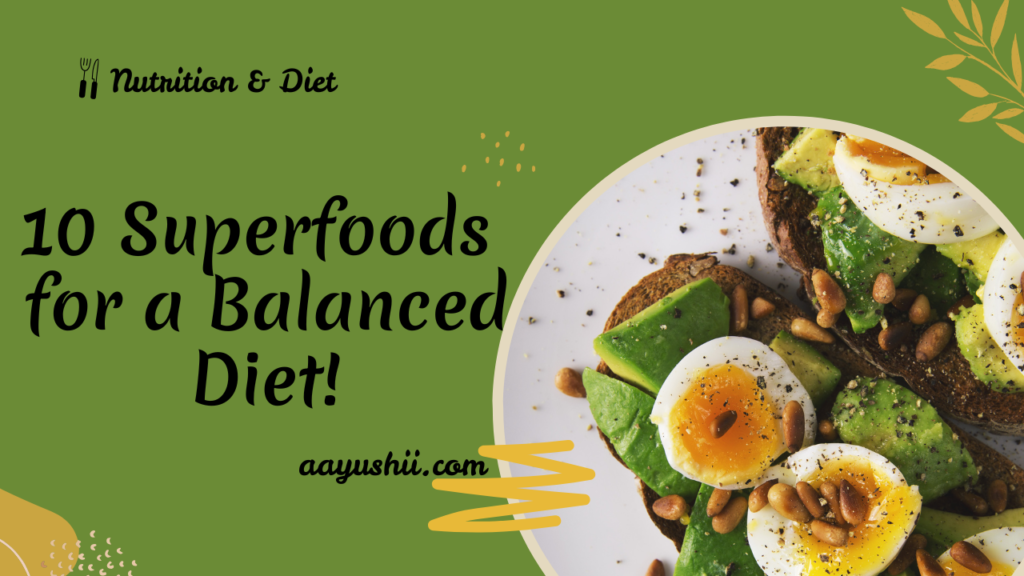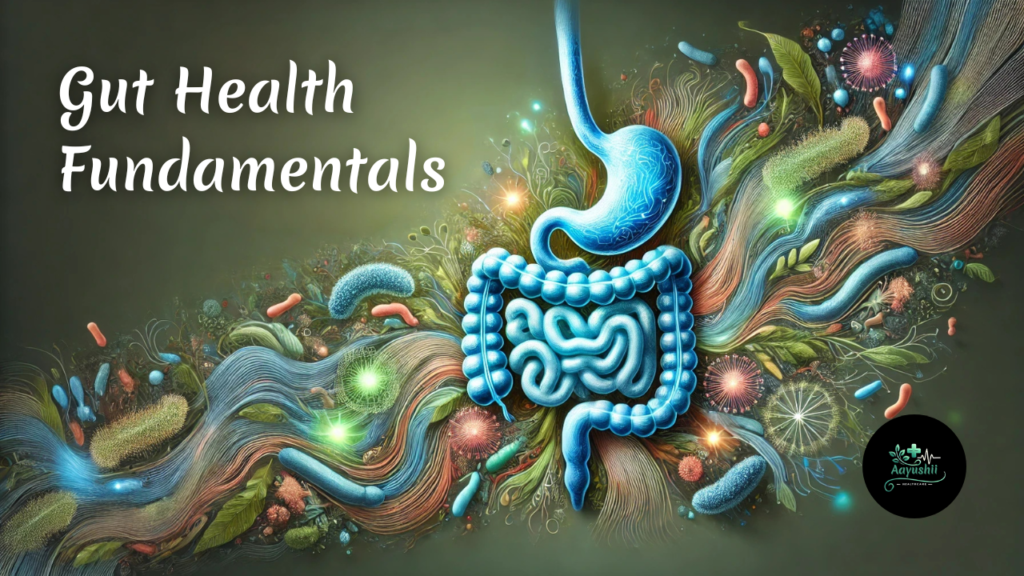In today’s world of ever-evolving diet trends, mixed messages about health, and an overwhelming array of packaged products promising to be “healthy,” the importance of understanding balanced nutrition has never been greater. At the heart of achieving optimal health, sustaining energy, maintaining a healthy weight, and ensuring lasting well-being lies a simple yet powerful truth: your body needs the right nutrients in the right proportions.
Balanced nutrition is not about chasing the latest fad or obsessively cutting calories. Instead, it’s a thoughtful, holistic approach that emphasizes the importance of macronutrients (proteins, carbohydrates, and fats), the critical role of micronutrients (vitamins and minerals), and the art of mindful portion control. Mastering these three elements lays the foundation for a sustainable eating pattern that nourishes your body, energizes your mind, and enhances your overall vitality.
This guide is your roadmap to balanced nutrition. You’ll discover how to choose nutrient-dense foods, build meals that deliver all the essential nutrients, and practice portion control without sacrificing satisfaction. By the end, you’ll have the tools and knowledge to make informed, empowering choices about your diet—helping you thrive and feel your best every day.
Table of Contents
Understanding Balanced Nutrition
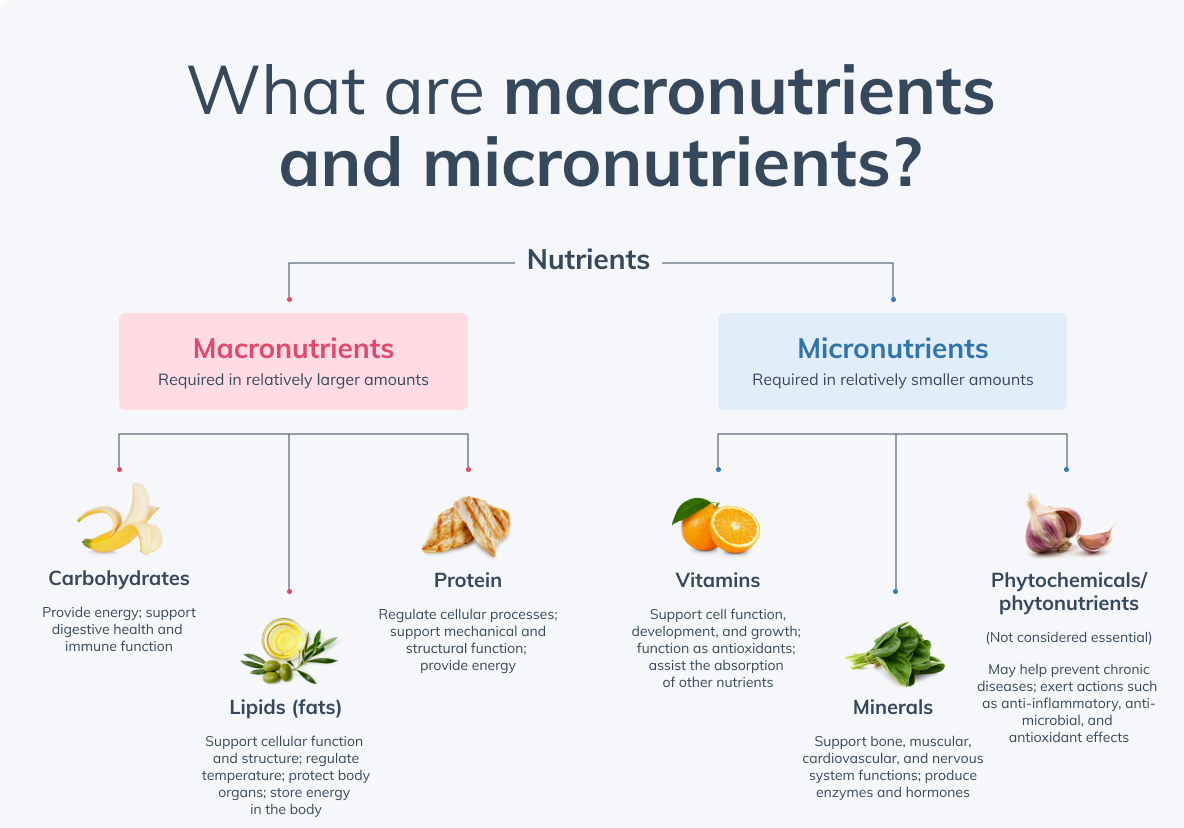
What Is Balanced Nutrition?
Balanced nutrition is the cornerstone of a healthy and thriving body. It involves consuming a wide variety of foods that supply all the essential nutrients your body needs, including macronutrients (proteins, carbohydrates, and fats) and micronutrients (vitamins, minerals, and phytonutrients). The emphasis of balanced nutrition goes beyond merely counting calories; it prioritizes the quality, diversity, and appropriate proportion of nutrients to maintain your body’s overall functionality and long-term health.
Balanced nutrition recognizes that nutrients don’t work in isolation—they function in synergy. Proteins help repair and build tissues, carbohydrates serve as the body’s primary energy source, and fats provide essential fatty acids and support hormonal balance. Meanwhile, micronutrients such as vitamins and minerals play crucial roles in metabolic processes, immune function, and cellular repair. A truly balanced diet ensures that these elements are present in adequate amounts to optimize your health and well-being.
Core Benefits of a Balanced Diet:
Meeting Energy Requirements:
A balanced diet provides the right number of calories to meet your body’s energy needs. These needs vary depending on factors such as age, gender, physical activity levels, and overall health. The calories you consume act as fuel, enabling you to perform daily activities, engage in physical exercise, and support essential bodily functions like breathing, digestion, and maintaining your heart rate.
Closing Nutritional Gaps:
Eating a variety of nutrient-rich foods helps cover all the essential vitamins, minerals, and other compounds your body requires to function optimally. A diet rich in whole foods like fruits, vegetables, whole grains, lean proteins, and healthy fats reduces the likelihood of deficiencies that can impair your immune system, weaken your bones, or disrupt other vital processes.
Promoting Long-Term Health:
Adopting a balanced nutrition approach can significantly lower the risk of chronic diseases such as heart disease, type 2 diabetes, obesity, and certain cancers. Whole, nutrient-dense foods often contain antioxidants and anti-inflammatory compounds that protect against cellular damage and chronic inflammation, two major contributors to these illnesses.
Key Principles of Balanced Nutrition:
Quality Over Quantity:
- It’s not just about the number of calories consumed but where they come from. Nutrient-dense foods such as fresh fruits, leafy greens, lean meats, nuts, and seeds provide more vitamins, minerals, and fiber compared to processed or sugary foods that may be calorie-dense but nutrient-poor.
Diversity and Variety:
- Your body benefits most from a wide range of nutrients. By including different colors, types, and textures of food on your plate, you expose yourself to a broader spectrum of essential compounds that work together to maintain health.
Portion Control and Moderation:
- Balancing your portions helps avoid overconsumption or undernutrition. This is particularly important for energy-dense foods like fats and sweets, which can contribute to weight gain and metabolic issues if eaten excessively.
By understanding and implementing these principles, you can create a sustainable eating pattern that fuels your body, promotes vitality, and reduces the risk of illness, empowering you to live a longer and healthier life.
Why Is Balanced Nutrition Important?
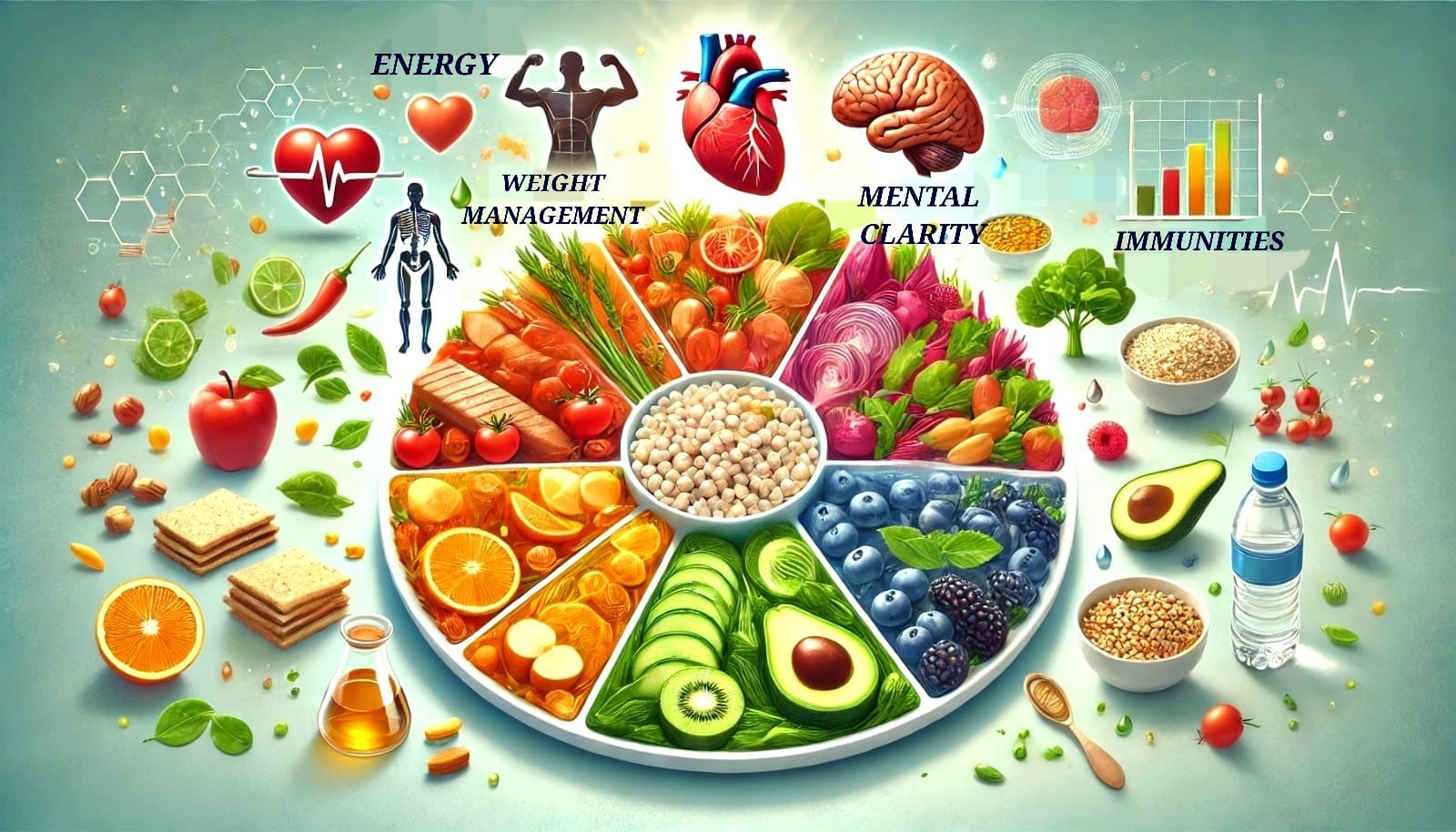
Balanced nutrition is vital for the optimal functioning of the human body, a highly complex organism that relies on a harmonious interplay of nutrients to sustain life. Every cell, tissue, and organ in your body depends on the nutrients you consume to perform its function effectively. Without the right balance of macronutrients and micronutrients, your body struggles to maintain its systems, leading to both immediate and long-term health issues. Below, we delve deeper into the science behind the benefits of balanced nutrition.
Key Benefits of Balanced Nutrition:
1. Sustained Energy Levels
The body primarily relies on carbohydrates, proteins, and fats for energy. Carbohydrates, broken down into glucose, are the body’s most accessible energy source, while fats provide a long-lasting energy reserve. Proteins support energy production during prolonged periods of fasting or high physical stress.
- Science Insight: A balanced intake of complex carbohydrates (like whole grains), healthy fats (such as omega-3 fatty acids), and adequate protein ensures steady blood sugar levels, avoiding energy spikes and crashes. This stability helps you remain focused, productive, and motivated throughout the day.
2. Improved Mental Clarity and Mood
Nutrients like omega-3 fatty acids, B-vitamins, and amino acids are crucial for brain health. Omega-3s, found in fatty fish, walnuts, and flaxseeds, are integral components of brain cell membranes and help regulate neurotransmitter activity. B-vitamins, such as folate and B6, contribute to the production of serotonin and dopamine, neurotransmitters that influence mood and cognition.
- Science Insight: Studies show that deficiencies in these nutrients can lead to cognitive decline, memory problems, and mood disorders like depression. For example, a lack of omega-3s has been linked to higher rates of anxiety and depression, while insufficient folate may impair mental clarity and lead to fatigue.
3. Strong Immune System
The immune system depends on a steady supply of nutrients to produce immune cells and maintain their functionality. Vitamin C (found in citrus fruits), vitamin E (in nuts and seeds), and zinc (present in lean meats and legumes) act as antioxidants, protecting cells from oxidative damage. Vitamin A, found in carrots and sweet potatoes, supports mucosal barriers that prevent pathogens from entering the body.
- Science Insight: Research indicates that nutrient deficiencies weaken the immune response, making you more susceptible to infections and prolonged recovery times. For example, zinc is essential for T-cell function, a critical component of adaptive immunity.
4. Weight Management
Balanced nutrition supports healthy weight management by promoting the consumption of nutrient-dense foods that are naturally lower in calories and high in satiety. Whole foods like fruits, vegetables, lean proteins, and whole grains provide fiber and protein, which slow digestion and reduce hunger.
- Science Insight: Studies have demonstrated that diets rich in fiber (20–30 grams daily) are associated with lower body weight, as fiber enhances feelings of fullness and reduces calorie intake. Similarly, protein helps maintain lean muscle mass during weight loss, which is essential for metabolic health.
5. Disease Prevention
Chronic diseases such as heart disease, type 2 diabetes, and certain cancers are strongly influenced by diet. A balanced diet rich in antioxidants, fiber, and essential vitamins and minerals can reduce inflammation and protect against these diseases.
- Science Insight:
- Heart Disease: Soluble fiber (found in oats, beans, and fruits) lowers LDL cholesterol, reducing the risk of atherosclerosis. Omega-3 fatty acids reduce triglycerides and improve heart rhythm.
- Type 2 Diabetes: Diets emphasizing whole grains, legumes, and vegetables help maintain stable blood sugar levels by slowing the absorption of glucose.
- Cancer: Phytochemicals like flavonoids and carotenoids, found in colorful fruits and vegetables, protect cells from oxidative stress and mutations that can lead to cancer.
The Risks of Poor Nutrition
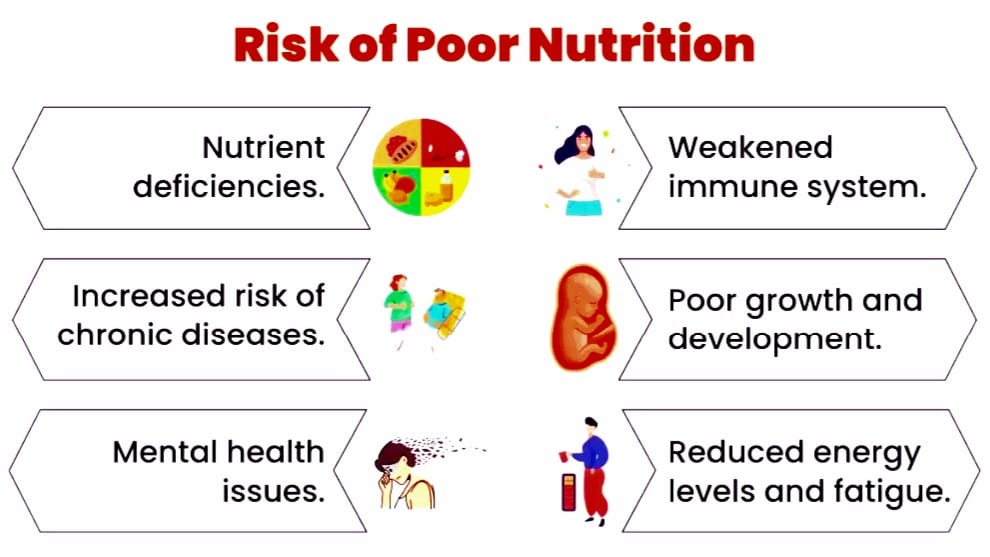
When the diet lacks essential nutrients, the body begins to exhibit warning signs:
- Fatigue: A lack of calories or iron impairs oxygen transport, causing tiredness.
- Weakened Immunity: Deficiencies in vitamins like C and D reduce the body’s ability to fight infections.
- Cognitive Decline: Insufficient omega-3s and B-vitamins can lead to memory problems and decreased mental performance.
- Chronic Disease Risks: Diets high in processed foods, sugars, and unhealthy fats promote inflammation, a driver of many chronic diseases.
By prioritizing balanced nutrition, you not only address immediate needs like energy and focus but also lay the groundwork for a healthier future. A nutrient-rich diet is your body’s best defense against illness and its most reliable source of vitality.
The Role of Macronutrients (Macros)
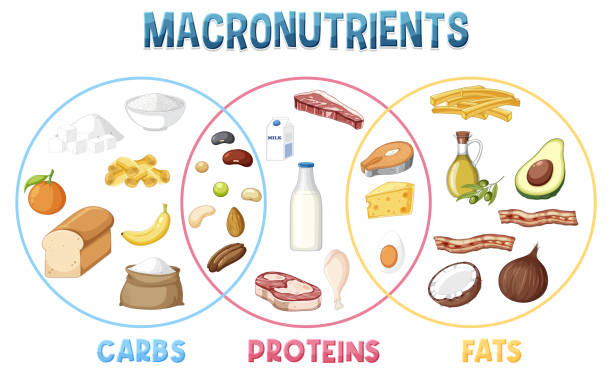
Macronutrients are the nutrients your body requires in large amounts. They provide the calories (energy) necessary to fuel vital functions and support growth, repair, and overall well-being. The three primary macronutrients are:
- Proteins
- Carbohydrates
- Fats
Proteins: The Body’s Building Blocks

What Are Proteins?
Proteins are essential macromolecules made up of smaller units called amino acids. These amino acids are linked in specific sequences to form unique protein structures that serve a wide array of functions in the body. Your muscles, skin, hair, nails, and organs all rely on proteins for growth and maintenance. Enzymes, hormones, and antibodies are also protein-based, making protein intake crucial for maintaining a strong immune system, regulating metabolism, and supporting overall health. That’s why Proteins, often referred to as the body’s ‘building blocks,’ are essential for the growth, repair, and maintenance of various tissues and systems.
Amino Acids: The Foundation of Proteins
Amino acids fall into three categories:
- Essential Amino Acids: These cannot be produced by the body and must be obtained from food sources like meat, dairy, eggs, soy, quinoa, and certain legumes.
- Non-Essential Amino Acids: These are synthesized by the body from other amino acids or nutrients.
- Conditionally Essential Amino Acids: These are usually non-essential but become critical during periods of stress, illness, or injury.
Key Roles of Proteins in the Body
- Tissue Growth and Repair: Proteins are integral for repairing muscles, skin, and other tissues after daily wear and tear, physical activity, or injury.
- Structural Support: Collagen and keratin, protein types, form the structural framework of connective tissues, hair, nails, and skin.
- Enzymatic Activity: Enzymes are specialized proteins that accelerate chemical reactions in the body, enabling processes like digestion and energy production.
- Hormonal Regulation: Many hormones, such as insulin and growth hormone, are protein-based and play a role in regulating metabolism, growth, and other bodily functions.
- Immune Defense: Antibodies are proteins that detect and neutralize harmful pathogens, bolstering the immune system.
- Transport and Storage: Proteins like hemoglobin transport oxygen in the blood, while others store nutrients for later use.
- Satiety and Weight Management: Protein tends to increase feelings of fullness, helping control appetite and support weight management efforts.
Dietary Protein and Health
Consuming sufficient protein is vital for overall health. The body’s protein needs vary depending on factors like age, gender, activity level, and health status.
- Animal Sources: High-quality proteins from sources like meat, fish, eggs, and dairy provide all essential amino acids.
- Plant-Based Sources: Foods such as beans, lentils, tofu, nuts, and seeds are excellent protein options, often requiring combinations to ensure all essential amino acids are consumed.
Protein Deficiency: Impacts and Implications
Protein deficiency occurs when the body does not receive enough protein to support its essential functions, leading to significant health challenges. Proteins are critical for building and repairing tissues, producing enzymes and hormones, and supporting immune responses. A lack of sufficient protein can result in both short-term and long-term complications.
Common Symptoms of Protein Deficiency
- Muscle Wasting: Without adequate protein, the body breaks down muscle tissue to meet its energy and repair needs, leading to loss of strength and mobility.
- Weakened Immunity: Proteins are essential for producing antibodies and immune cells. A deficiency can impair the immune system, making the body more susceptible to infections and illnesses.
- Fatigue and Weakness: Proteins contribute to energy production. Inadequate intake often results in chronic tiredness and a reduced ability to perform physical activities.
- Delayed Wound Healing: Proteins are necessary for cell regeneration and repair. A deficiency slows the healing of injuries, cuts, or surgical wounds.
- Edema: Insufficient protein can cause fluid imbalances, leading to swelling, particularly in the legs and feet.
Severe Protein Deficiency: Kwashiorkor and Marasmus
In extreme cases, particularly in malnourished populations, protein deficiency manifests as:
- Kwashiorkor: A severe form of protein malnutrition, characterized by swelling (edema), an enlarged liver, skin conditions, hair discoloration, and growth delays.
- Marasmus: A condition caused by a general deficiency of calories and protein, leading to extreme thinness, muscle wasting, and stunted growth.
Importance of Addressing Protein Deficiency
Ensuring adequate protein intake supports structural, metabolic, and immune functions essential for overall health and vitality. Regular consumption of diverse protein sources—both animal-based (meat, fish, dairy, eggs) and plant-based (legumes, nuts, seeds, soy)—can help meet dietary needs.
By understanding the critical role of proteins and integrating sufficient amounts into your diet, you empower your body to function optimally, recover effectively, and maintain resilience against health challenges.
How Much Protein Do You Need?
Protein requirements are not one-size-fits-all. They depend on a variety of factors, including your age, gender, activity level, body composition, and overall health goals. Understanding your individual protein needs is crucial to optimizing health, performance, and recovery.
General Protein Guidelines
The Recommended Dietary Allowance (RDA) for protein is 0.8 grams per kilogram of body weight (approximately 0.36 grams per pound) for the average adult. This amount is considered the minimum required to prevent deficiency in sedentary individuals. However, this baseline may not be adequate for people with higher protein demands.
Protein Needs for Specific Groups
- Active Individuals and Athletes:
- Endurance Athletes: Require 1.2–1.4 grams per kilogram of body weight daily to repair muscle fibers and replenish energy reserves.
- Strength Athletes: Those engaged in resistance training or muscle building often need 1.6–2.0 grams per kilogram to support muscle growth and repair.
- Older Adults:
- With age, the body becomes less efficient at using protein to maintain muscle mass and repair tissues. Protein needs increase to 1.0–1.2 grams per kilogram to counteract age-related muscle loss (sarcopenia).
- Pregnant and Breastfeeding Women:
- Protein intake should increase by 25 grams per day to support fetal development and milk production, which translates to approximately 1.1–1.3 grams per kilogram of body weight.
- Individuals with Specific Health Goals:
- Weight Management: Higher protein intake (around 1.2–1.6 grams per kilogram) can help preserve muscle mass during weight loss and increase satiety.
- Recovery from Illness or Surgery: Protein needs are elevated to promote healing, often exceeding 1.5 grams per kilogram, depending on the severity of the condition.
How to Calculate Your Protein Needs
- Determine Your Weight in Kilograms: Divide your weight in pounds by 2.2. For example, a 150-pound individual weighs approximately 68 kilograms (150 pounds ÷ 2.2 = 68.18 kilograms).
- Select a Protein Range: Choose the appropriate multiplier based on your activity level and health goals. For example, an active person may aim for 1.2–1.6 grams per kilogram.
- Minimum: 68.18 kg × 1.2 g = 81.82 grams of protein per day
- Maximum: 68.18 kg × 1.6 g = 109.09 grams of protein per day
- Calculate Total Protein: Multiply your weight in kilograms by the chosen range. For example, a 68-kilogram individual aiming for 1.5 grams per kilogram would need about 102 grams of protein daily.
Adjusting Protein Intake
- Overconsumption: While protein is essential, excessively high intakes (e.g., above 2.2 grams per kilogram) may not provide additional benefits and could strain the kidneys in individuals with preexisting kidney conditions.
- Under consumption: Chronic insufficient protein intake can lead to muscle loss, fatigue, and poor recovery.
Practical Tips for Meeting Protein Needs
- Distribute Protein Throughout the Day: Aim for balanced meals containing 20–30 grams of protein to maximize muscle protein synthesis.
- Diversify Protein Sources: Include both animal-based (e.g., lean meats, eggs, dairy) and plant-based options (e.g., beans, lentils, tofu).
- Supplement if Necessary: Protein powders can be a convenient way to meet higher needs, particularly for athletes or individuals with limited time.
By tailoring protein intake to your unique lifestyle and health requirements, you can optimize muscle maintenance, recovery, and overall well-being.
Carbohydrates: The Body’s Preferred Energy Source

What Are Carbohydrates?
Carbohydrates, commonly referred to as “carbs,” are organic compounds composed of carbon, hydrogen, and oxygen. They serve as the body’s primary energy source, playing a critical role in supporting both daily activities and vital physiological functions. Carbohydrates are particularly valued for their ability to provide quick, efficient energy, as they are easily converted into glucose—a simple sugar that fuels the body’s cells.
The key Role of Carbohydrates in the Body
- Energy Production:
- When you consume carbohydrates, your body breaks them down into glucose. This glucose is transported via the bloodstream to cells, where it is used to produce adenosine triphosphate (ATP)—the energy currency of the body.
- Excess glucose is stored as glycogen in the liver and muscles. During periods of intense activity or fasting, glycogen is broken down to maintain blood sugar levels and provide energy.
- Brain Function:
- Glucose is the primary energy source for the brain. Without adequate carbohydrate intake, cognitive functions such as memory, focus, and decision-making can be impaired.
- Low-carb diets can sometimes lead to symptoms like brain fog or difficulty concentrating due to a lack of sufficient glucose for brain cells.
- Digestive Health:
- Carbohydrate-rich foods like whole grains, fruits, and vegetables are excellent sources of dietary fiber. Fiber promotes gut health by:
- Supporting the growth of beneficial gut bacteria.
- Enhancing bowel regularity and preventing constipation.
- Reducing the risk of gastrointestinal diseases like diverticulosis.
- Protein Sparing:
- When carbohydrate intake is sufficient, the body relies on glucose for energy rather than breaking down proteins. This protein-sparing effect allows proteins to fulfill their primary roles in building and repairing tissues.
- Nutrient Absorption and Overall Health:
- Many carbohydrate-rich foods—such as fruits, vegetables, and legumes—are dense in essential nutrients, including vitamins, minerals, and antioxidants. These compounds work synergistically to reduce inflammation, boost the immune system, and lower the risk of chronic diseases.
Quality Carb Sources:
- Complex Carbohydrates: Whole grains (brown rice, quinoa, whole wheat bread, oats), legumes, starchy vegetables (sweet potatoes, butternut squash).
- Fruits and Vegetables: Berries, apples, spinach, broccoli, kale, carrots—these provide fiber, vitamins, and antioxidants.
- Minimal Processed Sugars: Limit refined carbohydrates like white bread, sugary cereals, pastries, and candy.
Carbohydrate Deficiency: Understanding Its Effects on the Body
Carbohydrate deficiency, also known as low-carb intake, occurs when the body does not receive an adequate amount of carbohydrates to meet its energy needs. This can result from restrictive diets, prolonged fasting, or insufficient calorie consumption. Since carbohydrates are the body’s primary energy source, their deficiency can significantly impact physical and mental health.
Signs and Symptoms of Carbohydrate Deficiency
- Fatigue and Low Energy:
- Without sufficient carbohydrates, the body struggles to produce glucose, leading to decreased energy levels. This is particularly noticeable during physical activities or mentally demanding tasks.
- Brain Fog:
- Glucose is the brain’s main energy source. A lack of carbs can impair cognitive function, causing difficulty concentrating, poor memory, and mental sluggishness.
- Muscle Weakness and Breakdown:
- In the absence of glucose, the body begins breaking down proteins (from muscle tissues) to produce energy through a process called gluconeogenesis. Over time, this can lead to muscle loss and weakness.
- Ketosis and Bad Breath:
- When carbohydrate intake is extremely low, the body switches to burning fats for energy, producing ketones as a byproduct. This state, known as ketosis, can cause a characteristic fruity or acetone-like breath.
- Digestive Issues:
- Carbohydrate-rich foods are often high in fiber. A deficiency may lead to constipation, irregular bowel movements, or other gastrointestinal discomforts.
- Mood Swings and Irritability:
- Fluctuating blood sugar levels caused by insufficient carb intake can trigger mood changes, irritability, or even symptoms of anxiety and depression.
Health Risks of Chronic Carbohydrate Deficiency
- Impaired Physical Performance:
- Athletes and active individuals may experience a significant decline in stamina and endurance due to depleted glycogen stores in muscles.
- Hormonal Imbalances:
- Prolonged carbohydrate restriction can disrupt hormone levels, particularly those related to reproduction and stress, such as cortisol and thyroid hormones.
- Increased Risk of Nutrient Deficiencies:
- Many carbohydrate sources, such as fruits and whole grains, are rich in vitamins, minerals, and antioxidants. Avoiding these foods may result in deficiencies in essential nutrients like vitamin C, B vitamins, and magnesium.
- Immune System Suppression:
- Carbohydrates support the immune system by fueling white blood cells. Chronic deficiency may weaken the body’s ability to fight infections.
Causes of Carbohydrate Deficiency
- Low-Carb Diets:
- Diets such as keto or Atkins often limit carb intake to induce weight loss, but they may lead to unintended side effects if not properly balanced.
- Eating Disorders:
- Conditions like anorexia or extreme calorie restriction can result in insufficient carbohydrate intake.
- Chronic Illness or Malabsorption:
- Conditions such as celiac disease or irritable bowel syndrome (IBS) may hinder the absorption of carbohydrates, leading to deficiency.
How to Address Carbohydrate Deficiency
- Reintroduce Healthy Carbs Gradually:
- Include nutrient-dense, whole food sources like fruits, vegetables, legumes, and whole grains.
- Balance Macronutrients:
- Combine carbs with proteins and healthy fats to stabilize energy levels and support overall health.
- Focus on Fiber-Rich Options:
- Opt for high-fiber carbs, such as oats, quinoa, and leafy greens, to support digestion and prevent blood sugar spikes.
- Monitor Carb Intake for Specific Needs:
- Adjust your carbohydrate consumption based on your activity level, age, and health goals to ensure adequate energy supply without overloading.
How Much Carbohydrate Do You Need?
Carbohydrate needs vary based on factors like activity level, metabolic health, and personal goals. The general recommendation is that 45–65% of daily calories should come from carbohydrates.
- Highly Active Individuals: Athletes or those engaging in intense physical activity may require a higher carbohydrate intake to replenish glycogen stores and support performance. In such cases, carbohydrates can make up a larger portion of daily calories, sometimes up to 60–70%.
- Weight Management and Blood Sugar Control: For those focusing on weight loss or managing blood sugar levels, a moderate to lower carbohydrate intake may be beneficial. This approach can help control calorie intake and prevent blood sugar spikes. Low-carb diets typically contain fewer than 20 to 120 grams of carbohydrates per day.
- General Population: For most people, carbohydrates should make up 45–65% of total daily calories. For example, on a 2,000-calorie diet, this equates to about 225 to 325 grams of carbohydrates per day.
It’s important to note that individual needs can vary. Consulting with a healthcare provider or registered dietitian can help determine the appropriate carbohydrate intake based on personal health goals and activity levels.
Fats: Essential for Hormones, Brain Health, and More

What Are Fats?
Fats, also known as lipids, are one of the three essential macronutrients (along with carbohydrates and proteins) that provide energy and perform critical functions in the body. Unlike their often-misunderstood reputation, fats are necessary for maintaining overall health and play a variety of structural, metabolic, and protective roles.
Types of Fats
- Saturated Fats
- Sources: Found primarily in animal products like meat, dairy, butter, and tropical oils (e.g., coconut and palm oil).
- Function: They provide stability to cell membranes and are a source of energy.
- Considerations: Excessive intake may raise LDL (bad cholesterol) levels, potentially increasing the risk of heart disease if not consumed in moderation.
- Unsaturated Fats
- Monounsaturated Fats: Found in olive oil, avocados, and nuts. They help lower bad cholesterol and reduce inflammation.
- Polyunsaturated Fats: Found in fatty fish, flaxseeds, and walnuts. These fats include omega-3 and omega-6 fatty acids, which are essential for brain function, reducing inflammation, and promoting heart health.
- Trans Fats
- Sources: Processed foods, baked goods, margarine, and fried items.
- Risks: Artificial trans fats are harmful as they increase LDL cholesterol while lowering HDL (good cholesterol), significantly raising the risk of heart disease.
Roles and Functions of Fats in the Body
- Energy Source
- Fats are calorie-dense, providing 9 calories per gram, more than double the energy of carbohydrates or proteins. This makes them a long-lasting energy source, especially during periods of fasting or low carbohydrate intake.
- Hormone Production
- Fats are essential for producing hormones like estrogen, testosterone, and cortisol, which regulate metabolism, reproduction, and stress responses.
- Cell Structure and Function
- Fat molecules form phospholipid bilayers, which make up the structure of cell membranes, maintaining fluidity and allowing cells to function properly.
- Absorption of Fat-Soluble Vitamins
- Vitamins A, D, E, and K require dietary fats for absorption and transportation. Without adequate fat intake, deficiencies in these vitamins may lead to poor vision, weak bones, and impaired immune function.
- Protection and Insulation
- Fats cushion and protect internal organs, acting as a shock absorber. They also help maintain body temperature by providing insulation.
- Brain Health
- The brain is composed of nearly 60% fat, and fats—especially omega-3 fatty acids—are crucial for cognitive function, memory, and mood regulation.
- Inflammation Control
- Essential fatty acids, particularly omega-3s, play a role in reducing inflammation and promoting heart and joint health.
The Importance of Healthy Fats
Consuming healthy fats, especially unsaturated fats, is linked to several health benefits, including:
- Improved Heart Health: Lowering bad cholesterol and reducing the risk of cardiovascular diseases.
- Brain and Eye Development: Supporting growth during pregnancy and early childhood.
- Better Skin Health: Keeping skin moisturized and reducing inflammation-related skin conditions.
- Weight Management: Providing satiety and helping regulate hunger hormones.
Balanced Fat Intake Recommendations
A well-balanced fat intake is essential for maintaining overall health while reducing the risk of chronic diseases such as heart disease, obesity, and diabetes. Here’s a more detailed explanation of fat consumption guidelines:
1. Total Fat Intake (20–35% of Daily Calories)
- The Dietary Guidelines for Americans recommend that 20–35% of your total daily calories come from fats. This range supports adequate energy levels, proper absorption of fat-soluble vitamins, and essential physiological functions.
- Example Calculation:
- For a 2,000-calorie diet, 20–35% translates to 400–700 calories from fat.
- Since fat provides 9 calories per gram, this equals approximately 44–78 grams of fat per day.
- Purpose: Staying within this range ensures you get the benefits of fats without excess intake, which could lead to weight gain or heart problems.
2. Saturated Fat Limit (Less than 10% of Daily Calories)
- Saturated fats, found primarily in animal products (butter, cheese, red meat) and tropical oils (coconut and palm oil), should make up less than 10% of total daily calories.
- Why Limit Saturated Fats?
High intake of saturated fats is associated with elevated LDL cholesterol (low-density lipoprotein), which can increase the risk of atherosclerosis (plaque buildup in arteries), leading to heart disease and stroke. - Example Calculation:
- In a 2,000-calorie diet, 10% equals 200 calories from saturated fat.
- Since fat has 9 calories per gram, this allows for about 22 grams of saturated fat daily.
- Better Alternatives:
Replace saturated fats with unsaturated fats (found in nuts, seeds, avocados, and olive oil) to improve heart health and maintain proper cholesterol levels.
3. Trans Fats (Avoid as Much as Possible)
- Sources:
Artificial trans fats are commonly found in processed foods, baked goods, fried items, and margarines. They are formed through a process called hydrogenation, which turns liquid oils into solid fats. - Health Risks:
Trans fats not only increase LDL (bad cholesterol) but also decrease HDL (good cholesterol), making them the most harmful type of fat for cardiovascular health. - Recommendation:
Avoid foods labeled with “partially hydrogenated oils” and choose fresh, whole foods over processed items. Since 2018, the FDA banned artificial trans fats in the U.S., but small amounts may still be present in some products.
4. Omega-3 and Omega-6 Balance
Omega-3 and Omega-6 fatty acids are essential polyunsaturated fats that the body cannot produce and must be obtained through diet.
Omega-3 Fatty Acids
- Sources: Fatty fish (salmon, sardines, mackerel), flaxseeds, chia seeds, walnuts, and algae-based supplements.
- Benefits:
- Reduce inflammation.
- Support heart health by lowering triglycerides and blood pressure.
- Improve brain function and mood regulation.
- Aid in joint health by reducing stiffness and swelling.
Omega-6 Fatty Acids
- Sources: Vegetable oils (soybean, corn, sunflower), nuts, and seeds.
- Benefits:
- Promote growth and development.
- Support skin and hair health.
- Regulate metabolism.
Balance Is Key
- While both omega-3 and omega-6 are necessary, the modern diet often provides too much omega-6 from processed oils and fried foods, leading to chronic inflammation.
- The ideal omega-6 to omega-3 ratio is approximately 4:1 or lower. However, typical Western diets may have a ratio closer to 15:1, contributing to inflammatory diseases.
- How to Improve the Ratio?
- Increase omega-3 intake from fatty fish, flaxseeds, and walnuts.
- Reduce processed foods rich in omega-6 oils and opt for natural, whole-food sources.
5. Types of Healthy Fats to Prioritize
- Monounsaturated Fats:
- Found in olive oil, avocados, almonds, and peanuts.
- Help reduce bad cholesterol and maintain heart health.
- Polyunsaturated Fats:
- Found in salmon, flaxseeds, walnuts, and soybeans.
- Provide essential fatty acids that the body cannot produce.
- Omega-3 Supplements:
- Ideal for individuals who do not consume fish regularly.
- Supports brain health, joint flexibility, and cardiovascular function.
Practical Tips for Balanced Fat Intake
- Cook with Healthy Oils: Use olive oil, avocado oil, or flaxseed oil instead of butter or margarine.
- Snack Smart: Replace chips and crackers with nuts, seeds, or hummus.
- Incorporate Fatty Fish: Aim for 2 servings per week of fish like salmon or mackerel.
- Limit Processed Foods: Avoid baked and fried products high in trans fats and refined oils.
- Read Labels: Look for terms like “partially hydrogenated oils” and avoid them.
The Importance of Micronutrients (Micros)
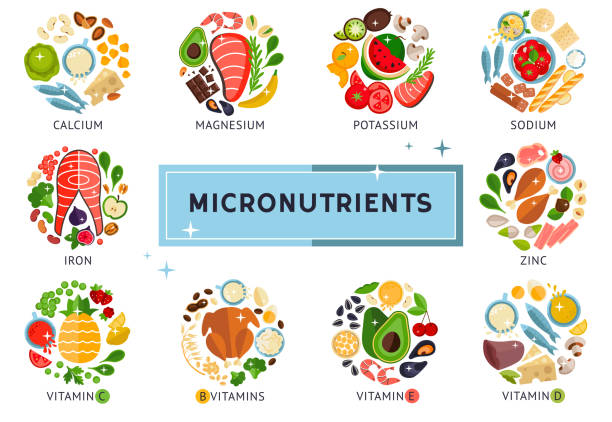
While macronutrients supply energy and building blocks, micronutrients—vitamins and minerals—serve as co-factors and regulators in thousands of biochemical reactions throughout the body. Even though they are required in smaller amounts, their impact on health is enormous.
Vitamins: Organic Compounds for Vital Functions
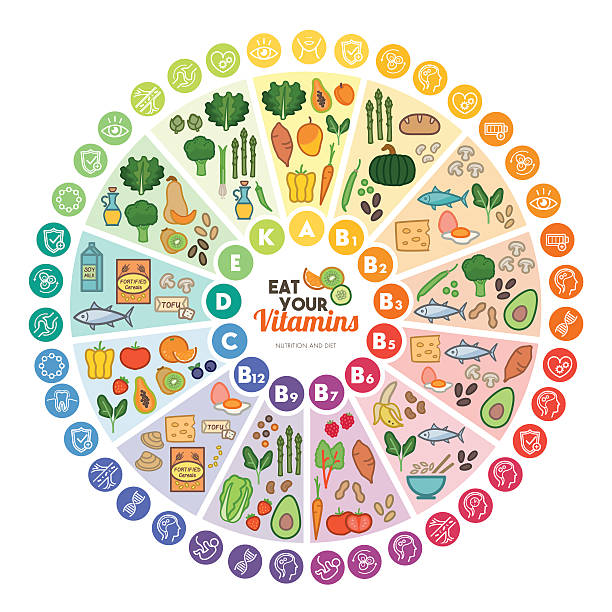
What Are Vitamins?
Vitamins are essential organic compounds that the body requires in small amounts to maintain proper growth, development, and overall health. Since the body either cannot produce them or produces them in insufficient quantities, they must be obtained through food or supplements. They play critical roles in energy production, immune defense, metabolism, and cell repair.
Types of Vitamins
1. Water-Soluble Vitamins
- Examples: Vitamin C and B vitamins (B1, B2, B3, B5, B6, B7, B9, B12).
- Absorption and Storage: Dissolve in water and are absorbed directly into the bloodstream.
- Storage: Not stored in the body in large amounts; excess is excreted through urine, requiring daily replenishment.
- Functions:
- Vitamin C: Supports collagen formation, strengthens immunity, and acts as an antioxidant.
- B Vitamins: Help in energy metabolism, red blood cell production, and maintaining healthy skin, nerves, and digestion.
2. Fat-Soluble Vitamins
- Examples: Vitamins A, D, E, and K.
- Absorption and Storage: Dissolve in fats and oils, absorbed along with dietary fats, and stored in the liver and fatty tissues.
- Storage: Because they can be stored, they do not need to be consumed daily, but excessive intake can lead to toxicity.
- Functions:
- Vitamin A: Important for vision, skin health, and immune function.
- Vitamin D: Aids in calcium absorption and bone health, and supports the immune system.
- Vitamin E: Acts as an antioxidant, protecting cells from damage caused by free radicals.
- Vitamin K: Essential for blood clotting and bone metabolism.
Key Differences Between Water-Soluble and Fat-Soluble Vitamins:
| Aspect | Water-Soluble Vitamins | Fat-Soluble Vitamins |
|---|---|---|
| Storage | Not stored; excess excreted in urine. | Stored in liver and fatty tissues; excess can build up. |
| Daily Requirement | Must be consumed regularly due to lack of storage. | Can be consumed less frequently due to storage capacity. |
| Absorption | Absorbed directly into the bloodstream. | Absorbed with dietary fat and requires bile for digestion. |
| Toxicity Risk | Low, as excess is excreted. | Higher, as excess can accumulate in tissues. |
Food Sources of Vitamins:
- Vitamin A: Sweet potatoes, carrots, spinach, cantaloupe.
- B Vitamins: Whole grains, legumes, nuts, leafy greens, animal proteins.
- Vitamin C: Citrus fruits, bell peppers, strawberries, broccoli.
- Vitamin D: Fatty fish, fortified dairy, egg yolks, exposure to sunlight.
- Vitamin E: Almonds, sunflower seeds, spinach, avocados.
- Vitamin K: Kale, spinach, broccoli, Brussels sprouts.
Importance of Vitamins:
- Energy Production: B vitamins help convert carbohydrates, fats, and proteins into energy.
- Growth and Repair: Vitamins support cell growth, tissue repair, and DNA synthesis.
- Immunity Boost: Vitamins like C and D strengthen the immune system, helping the body fight infections.
- Antioxidant Protection: Vitamins C and E neutralize free radicals to prevent cellular damage.
- Bone Health: Vitamins D and K are vital for calcium absorption and bone strength.
- Blood Clotting: Vitamin K ensures proper clotting to prevent excessive bleeding.
- Skin and Eye Health: Vitamins A and E maintain skin elasticity and vision
Minerals: Inorganic Elements for Structural and Regulatory Roles
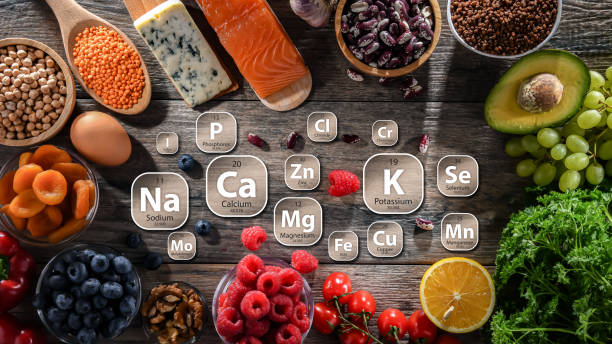
What Are Minerals?
Minerals are inorganic elements that are critical in building structures and regulating processes. Minerals are essential for maintaining physical structure (like bones and teeth), fluid balance, nerve signaling, and enzyme activity. While major minerals like calcium and magnesium are needed in larger amounts, trace minerals like zinc and selenium play equally critical roles in smaller doses. Some key minerals include:
1. Macrominerals (Major Minerals):
Needed in larger amounts for structural and regulatory functions.
- Calcium:
- Role: Builds and maintains strong bones and teeth, supports nerve transmission, muscle contraction, and blood clotting.
- Sources: Dairy products, leafy greens, almonds, fortified plant-based milk, and tofu.
- Deficiency Risks: Osteoporosis, muscle cramps, and weak teeth.
- Magnesium:
- Role: Participates in over 300 enzyme reactions, aids in muscle and nerve function, regulates blood sugar, and supports energy production and bone health.
- Sources: Nuts, seeds, whole grains, spinach, and legumes.
- Deficiency Risks: Muscle weakness, cramps, fatigue, and irregular heartbeat.
- Potassium:
- Role: Regulates fluid balance, maintains healthy blood pressure, aids in muscle contractions, and supports nerve signals.
- Sources: Bananas, potatoes, spinach, oranges, and beans.
- Deficiency Risks: Muscle weakness, cramps, irregular heart rhythm, and high blood pressure.
- Sodium:
- Role: Maintains fluid balance, regulates blood pressure, and supports nerve and muscle function.
- Sources: Salt, processed foods, and seafood.
- Excess Risks: High blood pressure, heart disease, and fluid retention.
- Phosphorus:
- Role: Strengthens bones and teeth, helps form DNA and RNA, and supports energy metabolism.
- Sources: Meat, dairy, fish, nuts, and legumes.
- Deficiency Risks: Weak bones, muscle weakness, and fatigue.
2. Trace Minerals (Microminerals):
Needed in smaller amounts but are equally important for health.
- Iron:
- Role: Helps form hemoglobin for oxygen transport in red blood cells and supports energy production and metabolism.
- Sources: Red meat, beans, spinach, lentils, tofu, and fortified cereals.
- Deficiency Risks: Fatigue, weakness, anemia, and impaired immunity.
- Zinc:
- Role: Supports immune function, wound healing, DNA synthesis, cell division, and proper growth.
- Sources: Meat, shellfish, nuts, seeds, and legumes.
- Deficiency Risks: Poor wound healing, hair loss, and weakened immunity.
- Selenium:
- Role: Acts as an antioxidant, supports thyroid hormone production, and boosts immunity.
- Sources: Brazil nuts, seafood, eggs, and whole grains.
- Deficiency Risks: Muscle weakness, fatigue, and thyroid dysfunction.
- Copper:
- Role: Aids in iron absorption, supports red blood cell production, and contributes to connective tissue formation.
- Sources: Nuts, seeds, whole grains, and shellfish.
- Deficiency Risks: Anemia, weak bones, and immune problems.
- Iodine:
- Role: Essential for thyroid hormone production, which regulates metabolism and growth.
- Sources: Iodized salt, seaweed, fish, and dairy.
- Deficiency Risks: Goiter (thyroid swelling) and hypothyroidism.
- Fluoride:
- Role: Strengthens teeth, prevents cavities, and supports bone health.
- Sources: Fluoridated water, tea, and seafood.
- Excess Risks: Dental or skeletal fluorosis (discoloration or bone damage).
- Manganese:
- Role: Supports bone health, collagen formation, and metabolism.
- Sources: Whole grains, nuts, and leafy greens.
- Deficiency Risks: Bone deformities and poor growth.
Food Sources of Minerals:
- Calcium: Dairy products, fortified plant milks, tofu, leafy greens.
- Iron: Red meat, legumes, spinach, fortified cereals, pumpkin seeds.
- Magnesium: Nuts, seeds, legumes, whole grains, leafy greens.
- Potassium: Bananas, potatoes, avocados, legumes, dried fruits.
- Zinc: Oysters, pumpkin seeds, chickpeas, meat, whole grains.
- Selenium: Brazil nuts, seafood, eggs, whole grains.
Key Functions of Minerals:
- Structural Support: Calcium, phosphorus, and magnesium contribute to the formation of bones and teeth.
- Fluid and Electrolyte Balance: Sodium, potassium, and chloride regulate water levels, blood pressure, and nerve function.
- Oxygen Transport: Iron ensures red blood cells carry oxygen efficiently.
- Nerve Transmission and Muscle Function: Calcium, magnesium, and potassium aid in nerve signaling and muscle contractions.
- Metabolic and Enzymatic Activities: Zinc, selenium, and copper assist enzymes in carrying out chemical reactions.
- Immune Health: Zinc and selenium protect cells from damage and support immune responses.
- Antioxidant Protection: Selenium and manganese neutralize harmful free radicals.
Phytonutrients and Antioxidants
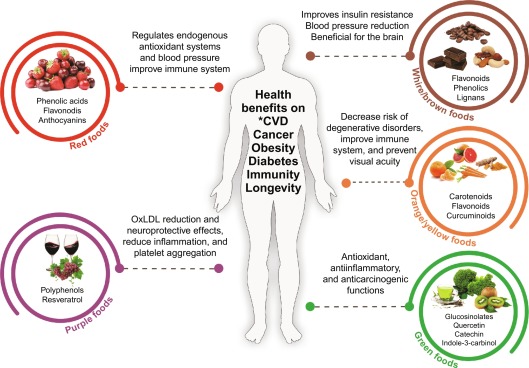
In addition to vitamins and minerals, whole foods—especially fruits, vegetables, herbs, and spices—contain phytonutrients and antioxidants. These compounds may not be classified as essential nutrients, but they provide numerous health benefits, including fighting inflammation, supporting heart health, and potentially reducing the risk of chronic diseases.
Examples of Phytonutrients:
- Flavonoids: Found in berries, tea, and dark chocolate, they support heart health and may improve cognitive function.
- Carotenoids: Pigments in fruits and vegetables like carrots, sweet potatoes, and tomatoes; they support eye health and act as antioxidants.
- Polyphenols: Found in grapes, berries, olives, and coffee; these compounds may help reduce inflammation and support metabolic health.
Portion Control: Quality and Quantity in Harmony
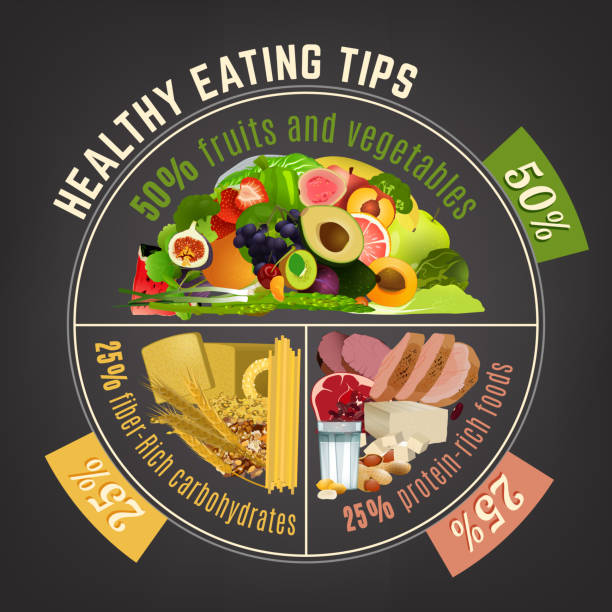
Even when you’ve mastered the art of choosing healthy foods, how much you eat can still make or break your overall nutrition strategy. Portion control is about eating the right amounts of foods to maintain energy balance, avoid excessive calorie intake, and prevent unwanted weight gain.
Why Portion Control Matters
- Calorie Balance: Consuming too many calories, even from healthy foods, can lead to weight gain. Portion control helps ensure you’re not overshooting your daily energy needs.
- Nutrient Density: By focusing on appropriate portions, you make room for a variety of nutrient-dense foods, ensuring a balanced micronutrient intake.
- Satiety and Satisfaction: Learning to eat just enough—neither too little nor too much—promotes better appetite regulation and enjoyment of meals.
Common Portion Control Challenges
- Supersized Portions: In many cultures, “bigger is better,” and we’re served portions far larger than we need.
- Mindless Eating: Snacking in front of the TV or computer makes it easy to lose track of how much you’re consuming.
- Emotional Eating: Stress, boredom, or sadness can push us to eat more than is necessary.
- Restaurant Meals: Dining out often means larger-than-ideal portion sizes.
Practical Strategies for Portion Control
- Use Smaller Plates and Bowls: A smaller plate naturally limits how much food you can fit on it, helping control calorie intake without feeling deprived.
- Measure and Weigh Foods at First: While this may feel cumbersome, measuring portions initially helps you learn what a standard portion looks like.
- Pre-Portion Snacks: Instead of eating directly from a bag, measure out a single serving size to avoid mindless overeating.
- Fill Up on Vegetables: Start meals with a salad or non-starchy veggies to increase volume and satiety before moving on to denser foods.
- Practice Mindful Eating: Slow down, chew thoroughly, and savor each bite. This helps your brain register fullness cues, preventing overeating.
- Use the “Plate Method”: Aim to fill half your plate with non-starchy vegetables, one-quarter with lean protein, and one-quarter with a complex carbohydrate source.
- Listen to Hunger and Fullness Cues: Learning to distinguish between true hunger and emotional or habitual eating can help you stop before you’re overly full.
Example of a Balanced Meal Portion
Imagine a dinner plate divided into sections:
- Half the Plate – Vegetables: Roasted broccoli, spinach salad, or grilled zucchini.
- One Quarter – Protein: A palm-sized portion of salmon or a scoop of lentils.
- One Quarter – Complex Carbs: A cup of quinoa or a small sweet potato.
- Healthy Fats (Added as a Topping): A drizzle of olive oil or a handful of sliced almonds.
This method ensures a balance of macros and offers a generous amount of micronutrients, all while keeping your total portion size in check.
Building a Balanced Plate: Putting It All Together
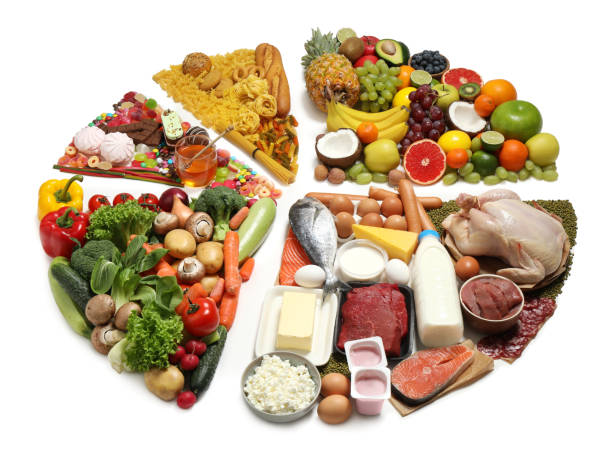
Achieving balanced nutrition involves combining the right types of foods in a way that meets your energy needs, supports your health goals, and satisfies your taste buds. Consider the following guidelines:
- Focus on Whole, Unprocessed Foods: Prioritize fruits, vegetables, whole grains, legumes, lean proteins, and healthy fats. Minimize ultra-processed foods high in added sugars, refined grains, and unhealthy fats.
- Aim for Variety: Include a colorful array of produce, rotate protein sources, and experiment with different whole grains. Variety ensures a broad spectrum of nutrients.
- Balance Macros in Each Meal: Aim to include a source of protein, a portion of complex carbohydrates, and a serving of healthy fats. This balance supports stable blood sugar levels, sustained energy, and satiety.
- Don’t Forget Micronutrients: Add plenty of fruits and vegetables to ensure you’re getting essential vitamins, minerals, and antioxidants.
- Adjust Portions as Needed: If you’re very active, you might need larger portions or more carbohydrate-rich foods. If you’re sedentary or focusing on weight loss, smaller portions and slightly adjusted macros may be necessary.
- Stay Hydrated: While not technically a macronutrient, water is essential for digestion, nutrient transport, temperature regulation, and overall health. Aim for at least 8–10 glasses per day, adjusting for climate and activity level.
Meal Timing and Frequency

Although the core principles of balanced nutrition revolve around what and how much you eat, when you eat can also impact how you feel and how well your body utilizes nutrients.
Should You Eat Three Meals a Day or More Frequently?
There’s no one-size-fits-all answer. Some people thrive on three square meals a day, while others feel better with smaller, more frequent meals. Consider the following factors:
- Energy Levels: Some individuals experience stable energy with three meals, while others benefit from a mid-afternoon snack to prevent an energy slump.
- Metabolism and Digestion: Spreading out food intake can aid digestion for those who feel sluggish after large meals.
- Personal Preference and Lifestyle: Your schedule, habits, and cultural norms may influence meal frequency.
Pre- and Post-Workout Nutrition
If you’re physically active, timing certain nutrients around your workouts can enhance performance and recovery.
- Pre-Workout: Consume a balanced meal or snack containing carbohydrates (for quick energy) and a moderate amount of protein about 1–2 hours before exercise.
- Post-Workout: Aim for a combination of protein (for muscle repair) and carbohydrates (to replenish glycogen stores) within 30–60 minutes after exercise. A Greek yogurt parfait with berries or a chicken breast with sweet potato are good options.
Adjusting for Different Dietary Patterns and Preferences

Balanced nutrition doesn’t have to look the same for everyone. Whether you follow a vegetarian, vegan, Mediterranean, or keto style of eating, the principles remain similar: prioritize nutrient-dense foods, ensure a variety of macro- and micronutrients, and keep portions in check.
Vegetarian and Vegan Diets
- Protein Sources: Legumes, tofu, tempeh, edamame, lentils, chickpeas, and seitan can help meet protein needs.
- Important Micronutrients: Ensure adequate intake of vitamin B12, iron, calcium, and zinc. Consider fortified foods or supplements if necessary.
- Healthy Fats: Avocados, nuts, seeds, and plant-based oils provide essential fatty acids.
Mediterranean Diet
- Focus on Whole Foods: Emphasize fruits, vegetables, whole grains, legumes, olive oil, and moderate fish and poultry intake.
- Healthy Fats: Extra-virgin olive oil and fatty fish are key for heart-healthy monounsaturated and omega-3 fats.
- Micronutrient-Rich: Plenty of antioxidants from colorful produce and herbs.
Low-Carb or Keto Diet
- Emphasis on Fat and Protein: Fats and proteins take center stage, with minimal carbohydrate intake.
- Micronutrient Considerations: Ensure adequate electrolyte intake (sodium, potassium, magnesium) to avoid imbalance.
- Quality Fats: Choose avocados, nuts, seeds, and olive oil over processed meats and butter for better overall nutrition.
Common Misconceptions About Balanced Nutrition

Myth 1: All Carbs Are Bad
Not all carbohydrates are equal. While refined sugar and white bread provide empty calories, complex carbs in whole grains, legumes, and vegetables deliver essential nutrients, fiber, and steady energy. Instead of eliminating carbs, focus on quality and portion size.
Myth 2: Fats Make You Fat
Healthy fats are crucial for hormone regulation, nutrient absorption, and brain function. The type and amount of fat matter more than the fact that it’s fat. Avocados, nuts, seeds, and fatty fish contribute to a balanced, heart-healthy diet.
Myth 3: More Protein Is Always Better
While protein is essential, excessively high protein diets offer diminishing returns and can sometimes strain the kidneys or crowd out other essential nutrients. Aim for a balanced approach that includes adequate protein, but don’t neglect carbs, fats, and micronutrients.
Myth 4: Supplements Can Replace a Poor Diet
While supplements can help fill nutrient gaps, they cannot replicate the complexity and synergy of whole foods. Relying solely on supplements to correct a poor diet misses out on the fiber, phytonutrients, and other beneficial compounds found in a well-rounded eating plan.
Myth 5: Eating Less Is Always Better
While reducing portion sizes can support weight loss, eating too little can backfire. Inadequate calorie intake leads to nutrient deficiencies, decreased energy, hormonal imbalances, and a slowed metabolism. The goal is balance, not constant restriction.
Tips for Making Balanced Nutrition Sustainable

Creating lifelong habits is key to enjoying the benefits of balanced nutrition. Consider these tips for making it stick:
- Set Realistic Goals: Start with small, achievable changes, like adding an extra serving of vegetables per day or reducing sugary drinks.
- Plan Meals and Snacks: Meal planning and prepping can help you avoid impulsive choices and ensure you always have healthy options on hand.
- Celebrate Progress, Not Perfection: Aim for consistency rather than perfection. Slip-ups happen—what matters is getting back on track.
- Stay Educated: Keep learning about nutrition. As science evolves, staying informed helps you make the best decisions for your health.
- Listen to Your Body: Cravings, hunger, and fullness cues can guide you. Over time, you’ll understand which foods and portions make you feel your best.
- Seek Professional Guidance: If you’re unsure about your nutritional needs, consider consulting a registered dietitian or a qualified nutrition professional.
Putting It All into Practice: A Sample Day of Balanced Eating

Breakfast (7 AM):
- Oatmeal cooked with low-fat milk, topped with blueberries, ground flaxseeds, and a dollop of Greek yogurt.
- A cup of green tea.
Mid-Morning Snack (10 AM):
- A handful of almonds and a small apple for fiber, healthy fats, and protein.
Lunch (1 PM):
- Quinoa bowl topped with grilled chicken breast, cherry tomatoes, spinach, and olive oil vinaigrette.
- A small side of sliced strawberries for antioxidants and vitamin C.
Afternoon Snack (4 PM):
- Carrot sticks with hummus for fiber and plant-based protein.
- A few walnuts for extra healthy fats.
Dinner (7 PM):
- Salmon fillet baked with lemon and herbs.
- Roasted sweet potatoes and a generous serving of steamed broccoli.
- A side salad with mixed greens, bell peppers, and a light drizzle of olive oil and vinegar.
Includes lean proteins, whole grains, healthy fats, and colorful fruits and vegetables for balanced nutrition. Portion sizes prevent overeating while sustaining energy. Flexible to fit preferences, dietary needs, and activity levels. Focuses on whole foods for long-term health, mindful eating, and stable energy throughout the day.
Conclusion
Balanced nutrition is more than just a diet—it’s a sustainable lifestyle that fuels your body, boosts energy, and promotes long-term vitality. By understanding the roles of macronutrients and micronutrients, prioritizing nutrient-dense foods, and practicing portion control, you can create eating habits that support your health goals without feeling restricted. Balanced eating isn’t about deprivation—it’s about making informed and mindful choices that align with your body’s needs, empowering you to thrive both physically and mentally.
Balanced fat intake isn’t just about cutting back; it’s about making smarter choices. Prioritizing healthy fats from sources like avocados, nuts, seeds, and fatty fish can support heart health, brain function, and hormone balance. At the same time, limiting unhealthy fats, such as trans fats and excessive saturated fats, reduces the risk of chronic diseases. By striking the right balance, you can enjoy the benefits of fats while safeguarding your long-term health—proving that nutrition is about nourishment, not restriction. For more informative, science-backed insights on health and wellness, visit aayushii.com.
FAQ: The Ultimate Guide to Balanced Nutrition: Macros, Micros & Portion Control
1. What are macronutrients and why do I need them?
Macronutrients—carbohydrates, proteins, and fats—are essential for providing energy, building muscle, and supporting overall body functions.
2. How do micronutrients contribute to my health?
Micronutrients, such as vitamins and minerals, play vital roles in supporting immunity, bone health, and energy production, even though they’re needed in smaller amounts.
3. How can I balance my meals effectively?
Focus on including a variety of food groups—fruits, vegetables, lean proteins, whole grains, and healthy fats—at every meal to ensure you’re meeting your nutritional needs.
4. What’s the best way to manage portion sizes?
Portion control can be achieved by using smaller plates, measuring food, and being mindful of hunger cues to avoid overeating.
5. Can I eat my favorite foods and still maintain a balanced diet?
Absolutely! Balance is key. Indulge occasionally, but focus on moderation and ensuring your overall diet supports your health goals.
6. How can I ensure I’m getting enough vitamins and minerals?
Eat a diverse range of colorful fruits and vegetables, incorporate whole grains and lean proteins, and consider fortified foods or supplements if needed.
7. How often should I eat to maintain energy throughout the day?
There’s no one-size-fits-all answer, but most people find that eating three balanced meals with 1–2 snacks keeps energy levels stable. Listen to your body and adjust accordingly.
8. What are some quick tips for improving my nutrition?
Start by adding more whole foods to your diet, reducing processed food intake, staying hydrated, and practicing mindful eating.
9. Can I still reach my health goals while eating out?
Yes! Many restaurants offer healthy options. Focus on lean proteins, vegetables, and healthy fats, and be mindful of portion sizes and added sugars or oils.
10. How do I know if I’m eating the right balance of nutrients?
Monitor how you feel—good energy levels, strong immunity, and overall well-being indicate you’re on track. For personalized advice, consider consulting a nutrition expert.


